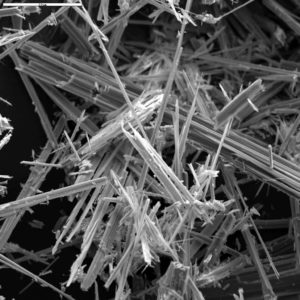SHP hears from Adam Clarke, Managing Director of Praxis42 Consulting on the different types of asbestos and managing the safety risks that come with it.
Foreword

Adam Clarke, Managing Director (Consulting) Praxis42.
I first learnt of asbestos as a teenager when my grandad passed away. He was in the building trade all his life and will have cut, installed and demolished huge quantities of asbestos without knowing how harmful it was. Add into the mix that he was a heavy smoker and you a high-risk combination for a lung-related condition.
Fast forward several decades and we should all know that asbestos exposure can be fatal. But how many of us know what to do if asbestos is found in or around the workplace, and what needs to be done to minimise the risk to employees and members of the public?
Despite asbestos being banned as a construction material since 1999, exposure to it is still the leading cause of UK work-related deaths. Around 5,000 workers each year die as a result of coming into contact with the almost-invisible asbestos fibres – that’s almost four times higher than the number of people killed on UK roads in 2021. Around 20 tradespeople each week die from past exposure to asbestos.
Asbestos-containing materials (ACMs) can be present in any building constructed or refurbished before 2000, so it’s important that we know what our responsibilities are as employers should asbestos be discovered or even suspected.
What is asbestos?
There are three main types of asbestos: amosite (brown asbestos) and crocidolite (blue asbestos) were both banned in 1985, whilst chrysotile (white asbestos) was fully banned in 1999.
Asbestos was widely used as a construction material from the 1950s onwards because of its low cost, strength and heat-resistant & electrical-insulation properties. The most common places to find it include:
- Ceiling tiles and voids, partition walls and fire door panels
- Insulation, such as lagging for boilers and pipes
- Asbestos cement, used in gutters, roofing and water tanks
- Textiles such as fire blankets and vinyl floor tiles
- Sprayed coatings, such as on ceilings, beams, walls and columns
What dangers does asbestos pose?
 If asbestos is left undisturbed and is in a good condition, it actually poses very little danger. It’s only when it is damaged that problems occur, due to the invisible fibres that are released into the air and breathed in.
If asbestos is left undisturbed and is in a good condition, it actually poses very little danger. It’s only when it is damaged that problems occur, due to the invisible fibres that are released into the air and breathed in.
These fibres can cause serious diseases, which can take decades to develop. These not only include lung diseases and cancers including mesothelioma, asbestosis and pleural thickening, but also vastly increase the risk of heart disease and strokes.
Duty-holders’ responsibilities
Measures have been put into place to help everyone act safely if asbestos is discovered. It all begins with The Control of Asbestos Regulations 2012, which place legal responsibilities on duty-holders of non-domestic, industrial, commercial and public buildings with ACMs.
Duty holders must identify asbestos (typically through asbestos surveys) and take action to minimise the risk of exposure. Those actions may include removing the asbestos altogether, or implementing an asbestos management plan, and must also include asbestos awareness training for employees who may come into contact with it. This is actually a wide group, including people who work in maintenance, installation, repairs and facilities, as well as contractors.
Many specialist companies provide this training online and most training can be completed in around half an hour.
Failing to have an effective asbestos management plan can result in a fine of up to £20,000 or up to six months in prison. Serious breaches can result in an unlimited fine and up to two years in prison.
Identifying and managing asbestos
When taking responsibility for a building built pre-2000 you should look for existing information to help understand the risk. This may include existing surveys, management plans or registers. If you do not have any information, you could contact previous owners, tenants, or even the architects.
If there is no information, you may need to arrange for a competent person to undertake a management survey. A management survey is for normal day-to-day occupation and maintenance of a building.
At the end of the process, you’ll need to create an asbestos register which records the types of asbestos found, its condition & location, and a material & priority score for each ACM. An accurate drawing should clearly show the locations of the ACMs. The HSE provides tools to help you do this, including an asbestos register template and a checklist for material and priority scores.
If construction work is to be carried out in a building, the risk of disturbing or damaging ACMs must be considered. If the construction work affects an area where asbestos has previously been identified or presumed, then a refurbishment / demolition survey will be required. The survey must locate all ACMs before any structural work begins.
The HSE states that a survey should be ‘comprehensive and systematic’, so you will need to decide whether you have the competency in-house to carry one out yourself, or to engage an external, qualified asbestos surveyor. I recommend the latter for peace of mind, particularly for the refurbishment/demolition survey which requires the potentially dangerous task of taking material samples for testing.
As a rule of thumb, when planning to carry out any work on a building that has been built or refurbished before 2000, assume that ACMs are present until you know otherwise.
Asbestos safety
As asbestos is such a tricky material to deal with safely, the general rule is only to allow competent/trained/specialist people with the right protective equipment to deal with it.
However, the following are all things to bear in mind if any material that could contain asbestos is encountered:
- Never break off a piece or disturb suspected ACMs
- Avoid contamination and exposing anyone to dust, particles or fibres from ACMs
- Ensure all employee asbestos-awareness training is completed satisfactorily
- Ensure you have an up-to-date asbestos management plan
- Always stop work immediately if ACMs are disturbed
Why should you subscribe to the SHP newsletter?
Do you want the very latest health and safety news, product launches, job listings and expert opinions sent straight to your inbox daily?
The SHP newsletter is essential reading – sign up today to get your hands on all this!


 If asbestos is left undisturbed and is in a good condition, it actually poses very little danger. It’s only when it is damaged that problems occur, due to the invisible fibres that are released into the air and breathed in.
If asbestos is left undisturbed and is in a good condition, it actually poses very little danger. It’s only when it is damaged that problems occur, due to the invisible fibres that are released into the air and breathed in.